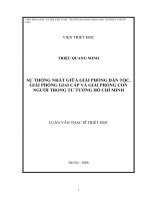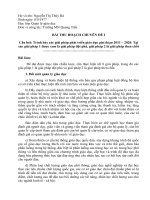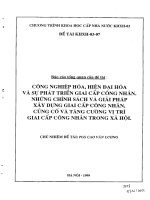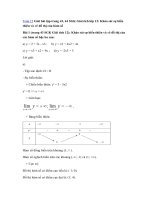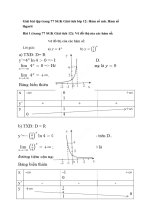20 câu ôn phần tiếng anh đánh giá năng lực đhqg tphcm phần 36 (bản word có giải)
Bạn đang xem bản rút gọn của tài liệu. Xem và tải ngay bản đầy đủ của tài liệu tại đây (124.78 KB, 10 trang )
20 câu ôn phần Tiếng Anh - Đánh giá năng lực ĐHQG TPHCM - Phần 36
(Bản word có giải)
1.2. TIẾNG ANH
Question 21-25. Choose a suitable word or phrase (marked A,B,C or D to fill in each blank)
21. I’m looking forward ______receiving your email soon
A. at
B. to
C. in
D. for
22. Jason told that he ___________his best in the exam the following day
A. had done
B. will do
C. would do
D. was going
23. The teacher encouraged us___________good essays
A. write
B. to write
C. writing
D. to writing
24. The cost of living_________over 10% in the last few years
A. rises
B. has risen
C. rose
D. is rising
C. was
D. were
25. A number of sheep_____eating grass now
A. is
B. are
Question 26-30. Each of the following sentences has one error (A,B,C, or D). Find it and blacken your
choice on your answer sheet
26. The explores were too tired that they found a site to camp overnight
A. too
B. that
C. to camp
D. overnight
27. All of the cities in Texas, San Antonio is probably the most picturesque
A. All of
B. in Texas
C. is probably
D. most picturesque
28. The scholarship that Wilson received to study history at Cambridge presented an unique opportunity
A. that
B. history
C. at Cambridge
D. an
29. A novel is story long enough to fill a complete book, in that the characters and events are usually
imaginary
A. long enough
B. complete
C. that
D. are usually
30. Preceding by four nice children, the bride and the groom entered the wedding hall
A. Preceeding
B. children
C. the
D. entered
Question 31-35. Which of the following best restates each of the given sentences?
31. I haven’t visited my hometown for a few years
A. I have been in my hometown for a few years
B. I was in my hometown for a few years
C. I didn’t visit my hometown a few years ago
D. I last visited my hometown a few years ago
32. You are all wellcome to take any food you like
A. Please help yourselves to any food you like
B. Any food welcome to take if you like
C. It’s my pleasure to take any food you like
D. You don’t have to pay for any food that you like
33. It is possible that she didn’t hear what I said
A. She may not have heard what I said
B. She might not hear what I said
C. She must not have heard what I said
D. She may not hear what I said
34. They were late for meeting because of the heavy snow
A. But for the heavy snow, they wouldn’t have been late for the meeting
B. Had it not snowed heavily, they would have been late for the meeting
C. If it snowed heavily, they would be late for the meeting
D. If it didn’t snow heavily, they wouldn’t be late for the meeting
35. Somebody repaired her bicycle last week
A. She had to repair her bicycle last week
B. She had her bicycle to repair last week
C. She had her bicycle repair last week
D. She had her bicycle repaired last week
Question 36-40. Read the passage carefully
Glass is a remarkable substance made from the simplest raw materials. It can be colored or colorless,
monochrome or polychrome, transparent, translucent, or opaque. It is lightweight impermeable to liquids,
readily cleaned and reused, durable yet fragile, and often very beautiful. Glass can be decorated in
multiple ways and its optical properties are exceptional. In all its myriad forms – as table ware,
containers, in architecture and design–glass represents a major achievement in the history of
technological developments.
Since the Bronze Age about 3,000 B.C., glass has been used for making various kinds of objects. It
was first made from a mixture of silica, line and an alkali such as soda or potash, and these remained the
basic ingredients of glass until the development of lead glass in the seventeenth century. When heated, the
mixture becomes soft and malleable and can be formed by various techniques into a vast array of shapes
and sizes. The homogeneous mass thus formed by melting then cools to create glass, but in contrast to
most materials formed in this way (metals, for instance), glass lacks the crystalline structure normally
associated with solids, and instead retains the random molecular structure of a liquid. In effect, as molten
glass cools, it progressively stiffens until rigid, but does so without setting up a network of interlocking
crystals customarily associated with that process. This is why glass shatters so easily when dealt a blow.
Why glass deteriorates over time, especially when exposed to moisture, and why glassware must be
slowly reheated and uniformly cooled after manufacture to release internal stresses induced by uneven
cooling.
Another unusual feature of glass is the manner in which its viscosity changes as it turns from a cold
substance into a hot, ductile liquid. Unlike metals that flow or “freeze” at specific temperatures glass
progressively softens as the temperature rises, going through varying stages of malleability until it flows
like a thick syrup. Each stage of malleability allows the glass to be manipulated into various forms, by
different techniques, and if suddenly cooled the object retains the shape achieved at that point. Glass is
thus amenable to a greater number of heatforming techniques than most other materials.
Choose an option (A,B,C, or D) that best answer each question
36. Why does the author list the characteristics of glass in paragraph 1?
A. To demonstrate how glass evolved
B. To show the versatility of glass
C. To explain glassmaking technology
D. To explain the purpose of each component of glass
37. The word “durable“‘ in paragraph 1 is closest in meaning to_ .
A. lasting
B. delicate
C. heavy
D. plain
38. What does the author imply about the raw materials used to make glass?
A. They were the same for centuries.
B. They are liquid.
C. They are transparent.
D. They are very heavy.
39. According to the passage, how is glass that has cooled and become rigid different from most other
rigid substances?
A. It has an interlocking crystal network.
B. It has an unusually low melting temperature.
C. It has varying physical properties.
D. It has a random molecular structure.
40. What must be done to release the internal stresses that build up in glass products during manufacture?
A. The glass must be reheated and evenly cooled.
B. The glass must be cooled quickly.
C. The glass must be kept moist until cooled.
D. The glass must be shaped to its desired form immediately
HƯỚNG DẪN GIẢI CHI TIẾT
1.2. TIẾNG ANH
Question 21-25. Choose a suitable word or phrase (marked A,B,C or D to fill in each blank)
21. I’m looking forward ______receiving your email soon
A. at
B. to
C. in
D. for
Phương pháp giải:
Giới từ
Giải chi tiết:
Look forward to doing sth: mong chờ điều gì
Tạm dịch: Tơi mong sớm nhận được thư của bạn
22. Jason told that he ___________his best in the exam the following day
A. had done
B. will do
C. would do
D. was going
Phương pháp giải:
Thì của động từ
Giải chi tiết:
“the follwing day” => ở câu trực tiếp: next day
Dùng thì tương lai đơn để đưa ra lời khẳng định, lời hứa => will + V
=> khi chuyển thành câu gián tiếp : would + V
Tạm dịch: Jason nói rằng anh ấy sẽ làm tốt nhất có thể trong bài kiểm tra vào ngày kia
23. The teacher encouraged us___________good essays
A. write
B. to write
C. writing
D. to writing
Phương pháp giải:
Dạng của động từ
Giải chi tiết:
Encourage sb to do sth: khuyến khích ai làm gì
Tạm dịch: Giáo viên khuyến khích chúng tôi viết tốt các bài luận
24. The cost of living_________over 10% in the last few years
A. rises
B. has risen
C. rose
D. is rising
C. was
D. were
Phương pháp giải:
Thì của động từ
Giải chi tiết:
in the past few years -> Dấu hiệu của thì HTHT
Tạm dịch: Chi phí sinh hoạt tăng trong vài năm qua
25. A number of sheep_____eating grass now
A. is
Phương pháp giải:
B. are
Sự hòa hợp chủ ngữ - động từ
Giải chi tiết:
Sheep (n) – con cừu => sheep (n) – đàn cừu [ dạng số ít và số nhiều giống nhau]
A number of + N số nhiều (một vài…) => động từ chia số nhiều
Tạm dịch: Một vài con cừu đang ăn cò lúc này
Question 26-30. Each of the following sentences has one error (A,B,C, or D). Find it and blacken your
choice on your answer sheet
26. The explores were too tired that they found a site to camp overnight
A. too
B. that
C. to camp
D. overnight
Phương pháp giải:
Cấu trúc “so/too”
Giải chi tiết:
Too + adj/adv (for sb) + to do sth
=> theo sau “too” là “to-V”
So + adj/adv + that + S + V
=> theo sau “so” là mệnh đề “that”
Sửa: too => so
Tạm dịch: Nhừng người khám phá quá mệt nên họ đã tìm địa điểm cắm trại qua đêm
27. All of the cities in Texas, San Antonio is probably the most picturesque
A. All of
B. in Texas
C. is probably
D. most picturesque
Phương pháp giải:
Từ vựng
Giải chi tiết:
All of + N số nhiều: tất cả
Among + N số nhiều: trong số
Sửa: all of => among
Tạm dịch: Trong số các thành phố ở Texas, San Antonio có lẽ là thành phố đẹp như tranh
28. The scholarship that Wilson received to study history at Cambridge presented an unique opportunity
A. that
B. history
C. at Cambridge
D. an
Phương pháp giải:
Mạo từ
Giải chi tiết:
Unique /juˈniːk/ bắt đầu bằng âm nguyên âm /ju/ => không dùng mạo từ “an”
Sửa: an => a
Tạm dịch: Học bổng mà Wilson nhận được để nghiên cứu lịch sử tại Cambridge đã mang đến một cơ hội
duy nhất
29. A novel is story long enough to fill a complete book, in that the characters and events are usually
imaginary
A. long enough
B. complete
C. that
D. are usually
Phương pháp giải:
Đại từ quan hệ
Giải chi tiết:
Enough + N (for sb) + to-V Adj + enough (for sb) to-V
=> đủ cho ai làm gì
Giời từ + which/whom => giới từ chỉ dùng với 2 đại từ quan hệ này
=> dùng “which” để thay thế cho danh từ chỉ vật “book”
Tạm dịch: Một cuốn tiểu thuyết là một câu chuyện đủ dài để lấp đầy một cuốn sách hồn chỉnh, trong đó
các nhân vật và sự kiện thường là tưởng tượng
30. Preceding by four nice children, the bride and the groom entered the wedding hall
A. Preceeding
B. children
C. the
D. entered
Phương pháp giải:
Rút gọn mệnh đề quan hệ
Giải chi tiết:
Chủ ngữ “the bride and the groom” là chủ ngữ của 2 mệnh đề , tuy nhiên không phải là chủ thể của hành
động “precede” => Dùng PII để rút gọn mệnh đề quan hệ dạng bị động
Sửa: preceding => preceded
Tạm dịch: Được bốn đứa trẻ tốt bụng dẫn trước, cô dâu và chú rể bước vào sảnh cưới
Question 31-35. Which of the following best restates each of the given sentences?
31. I haven’t visited my hometown for a few years
A. I have been in my hometown for a few years
B. I was in my hometown for a few years
C. I didn’t visit my hometown a few years ago
D. I last visited my hometown a few years ago
Phương pháp giải:
Thì quá khứ đơn
Giải chi tiết:
S + hasn’t/haven’t + Ved/V3 + for/since + time => S + last + Ved/V2 + time + ago
Tạm dịch: Tôi chưa về thăm quê một vài năm rồi = Lần cuối cùng tôi về thăm quê là một vài năm trước
32. You are all wellcome to take any food you like
A. Please help yourselves to any food you like
B. Any food welcome to take if you like
C. It’s my pleasure to take any food you like
D. You don’t have to pay for any food that you like
Phương pháp giải:
Câu đồng nghĩa
Giải chi tiết:
Help yourself to sth = welcome to take sth: cứ tự nhiên
A. Sai ngữ pháp vì any food là chủ ngữ số ít.
B. Hãy tự nhiên lấy bất cứ thức ăn nào mà bạn thích.
C. Bạn khơng phải trả tiền cho thức ăn mà bạn lấy.
D. Thật vinh dự cho tôi để lấy món ăn mà bạn thích
Tạm dịch: Bạn cứ tự nhiên lấy bất cứ thức ăn nào mà bạn thích.
33. It is possible that she didn’t hear what I said
A. She may not have heard what I said
B. She might not hear what I said
C. She must not have heard what I said
D. She may not hear what I said
Phương pháp giải:
Động từ khuyết thiếu
Giải chi tiết:
may have PII :chỉ 1 dự đốn ở q khứ ( khơng có cơ sở)
A. may V: dự đoán ở hiện tại hoặc tương lại ( khả năng cao)
B. might V: dự đoán ở hiện tại hoặc tương lai ( khả năng thấp)
C. might have PII: dự đốn ở q khứ ( khơng có cơ sở).
Cấu trúc ngữ pháp “may have PII” và “might have PII” có cùng cách sử dụng nhưng đáp án C sai do thiếu
“not” nên câu bị ngược nghĩa hồn tồn so với câu tiêu đề.
Tạm dịch: Có thể cơ ấy đã khơng nghe những điều mà tơi nói.
= Cơ ấy có lẽ đã khơng nghe những điều mà tơi nói.
34. They were late for meeting because of the heavy snow
A. But for the heavy snow, they wouldn’t have been late for the meeting
B. Had it not snowed heavily, they would have been late for the meeting
C. If it snowed heavily, they would be late for the meeting
D. If it didn’t snow heavily, they wouldn’t be late for the meeting
Phương pháp giải:
Câu điều kiện
Giải chi tiết:
Câu gốc đang đưa ra thực tế ở quá khứ => dùng câu điều kiện loại 3 hoặc cấu trúc tương đương để đưa ra
giả thiết trái ngược quá khứ
But for + N/Ving hoặc Had + S + Ved/V3, S + would have + Ved/V3
Khơng chọn B vì sai nghĩa
Tạm dịch: Nếu khơng vì tuyết rơi nặng hạt, họ đã không đến cuộc họp muộn
35. Somebody repaired her bicycle last week
A. She had to repair her bicycle last week
B. She had her bicycle to repair last week
C. She had her bicycle repair last week
D. She had her bicycle repaired last week
Phương pháp giải:
Cấu trúc nhờ vả
Giải chi tiết:
Have/get sth done: nhờ/thuê/yêu cầu ai đó làm gì cho mình ( chủ ngữ của câu khơng phải là người thực
hiện hành động này)
Tạm dịch: Cô ấy nhờ người sửa xe đạp tuần trước
Question 36-40. Read the passage carefully
Glass is a remarkable substance made from the simplest raw materials. It can be colored or colorless,
monochrome or polychrome, transparent, translucent, or opaque. It is lightweight impermeable to liquids,
readily cleaned and reused, durable yet fragile, and often very beautiful. Glass can be decorated in
multiple ways and its optical properties are exceptional. In all its myriad forms – as table ware,
containers, in architecture and design–glass represents a major achievement in the history of
technological developments.
Since the Bronze Age about 3,000 B.C., glass has been used for making various kinds of objects. It
was first made from a mixture of silica, line and an alkali such as soda or potash, and these remained the
basic ingredients of glass until the development of lead glass in the seventeenth century. When heated, the
mixture becomes soft and malleable and can be formed by various techniques into a vast array of shapes
and sizes. The homogeneous mass thus formed by melting then cools to create glass, but in contrast to
most materials formed in this way (metals, for instance), glass lacks the crystalline structure normally
associated with solids, and instead retains the random molecular structure of a liquid. In effect, as molten
glass cools, it progressively stiffens until rigid, but does so without setting up a network of interlocking
crystals customarily associated with that process. This is why glass shatters so easily when dealt a blow.
Why glass deteriorates over time, especially when exposed to moisture, and why glassware must be
slowly reheated and uniformly cooled after manufacture to release internal stresses induced by uneven
cooling.
Another unusual feature of glass is the manner in which its viscosity changes as it turns from a cold
substance into a hot, ductile liquid. Unlike metals that flow or “freeze” at specific temperatures glass
progressively softens as the temperature rises, going through varying stages of malleability until it flows
like a thick syrup. Each stage of malleability allows the glass to be manipulated into various forms, by
different techniques, and if suddenly cooled the object retains the shape achieved at that point. Glass is
thus amenable to a greater number of heatforming techniques than most other materials.
Choose an option (A,B,C, or D) that best answer each question
36. Why does the author list the characteristics of glass in paragraph 1?
A. To demonstrate how glass evolved
B. To show the versatility of glass
C. To explain glassmaking technology
D. To explain the purpose of each component of glass
Phương pháp giải:
Đọc hiểu suy luận
Giải chi tiết:
Tại sao tác giả lại liệt kê những đặc điểm của thủy tinh trong đoạn 1?
A. Để chứng minh thủy tinh đã phát triển như thế nào
B. Để thể hiện tính linh hoạt của thủy tinh
C. Để giải thích cơng nghệ sản xuất thủy tinh
D. Để giải thích mục đích của từng thành phần của thủy tinh
37. The word “durable“‘ in paragraph 1 is closest in meaning to_ .
A. lasting
B. delicate
C. heavy
D. plain
Phương pháp giải:
Từ vựng
Giải chi tiết:
Từ “durable“ (bền lâu) trong đoạn 1 gần nghĩa nhất với_______
A. lasting: bền
B. delicate: nhạy bén
C. heavy: nặng
D. plain: đơn giản
Thông tin: It is lightweight impermeable to liquids, readily cleaned and reused, durable yet fragile, and
often very beautiful.
Tạm dịch: Nó nhẹ, khơng thấm chất lỏng, dễ dàng làm sạch và tái sử dụng, bền nhưng dễ vỡ và thường
rất đẹp.
38. What does the author imply about the raw materials used to make glass?
A. They were the same for centuries.
B. They are liquid.
C. They are transparent.
D. They are very heavy.
Phương pháp giải:
Đọc hiểu suy luận
Giải chi tiết:
Tác giả ám chỉ điều gì về những ngun liệu thơ được sử dụng để làm thủy tinh?
A. Chúng giống nhau trong nhiều thế kỷ.
B. Chúng ở thể lỏng.
C. Chúng trong suốt.
D. Chúng rất nặng.
Thông tin: . It was first made from a mixture of silica, line and an alkali such as soda or potash, and these
remained the basic ingredients of glass until the development of lead glass in the seventeenth century
Tạm dịch: Đầu tiên nó được làm từ hỗn hợp silica, đường và một chất kiềm như soda hoặc kali, và
những thành phần này vẫn là thành phần cơ bản của thủy tinh cho đến khi thủy tinh chì phát triển vào thế
kỷ XVII.
39. According to the passage, how is glass that has cooled and become rigid different from most other
rigid substances?
A. It has an interlocking crystal network.
B. It has an unusually low melting temperature.
C. It has varying physical properties.
D. It has a random molecular structure.
Phương pháp giải:
Đọc hiểu chi tiết
Giải chi tiết:
Theo đoạn văn, thủy tinh đã nguội và trở nên cứng khác với hầu hết các chất cứng khác như thế nào?
A. Nó có một mạng lưới tinh thể lồng vào nhau.
B. Nó có nhiệt độ nóng chảy thấp bất thường.
C. Nó có các tính chất vật lý khác nhau.
D. Nó có cấu trúc phân tử ngẫu nhiên.
Thông tin: The homogeneous mass thus formed by melting then cools to create glass, but in contrast to
most materials formed in this way (metals, for instance), glass lacks the crystalline structure normally
associated with solids, and instead retains the random molecular structure of a liquid
Tạm dịch: Do đó, khối đồng nhất được hình thành bằng cách nấu chảy sau đó nguội đi để tạo ra thủy
tinh, nhưng trái ngược với hầu hết các vật liệu được hình thành theo cách này (ví dụ như kim loại), thủy
tinh thiếu cấu trúc tinh thể thường liên kết với chất rắn, và thay vào đó vẫn giữ cấu trúc phân tử ngẫu
nhiên của chất lỏng.
40. What must be done to release the internal stresses that build up in glass products during manufacture?
A. The glass must be reheated and evenly cooled.
B. The glass must be cooled quickly.
C. The glass must be kept moist until cooled.
D. The glass must be shaped to its desired form immediately
Phương pháp giải:
Đọc hiểu chi tiết
Giải chi tiết:
Phải làm gì để giải phóng ứng suất bên trong tích tụ trong các sản phẩm thủy tinh trong quá trình sản
xuất?
A. Ly phải được hâm nóng và làm nguội đều.
B. Phải làm nguội nhanh thủy tinh.
C. Thủy tinh phải được giữ ẩm cho đến khi nguội.
D. Thủy phải được định hình thành hình dạng mong muốn ngay lập tức
Thơng tin: Why glass deteriorates over time, especially when exposed to moisture, and why glassware
must be slowly reheated and uniformly cooled after manufacture to release internal stresses induced by
uneven cooling
Tạm dịch: Tại sao kính xuống cấp theo thời gian, đặc biệt là khi tiếp xúc với hơi ẩm, và tại sao dụng cụ
thủy tinh phải được hâm nóng lại từ từ và làm nguội đồng đều sau khi sản xuất để giải phóng ứng suất
bên trong do làm mát khơng đều
